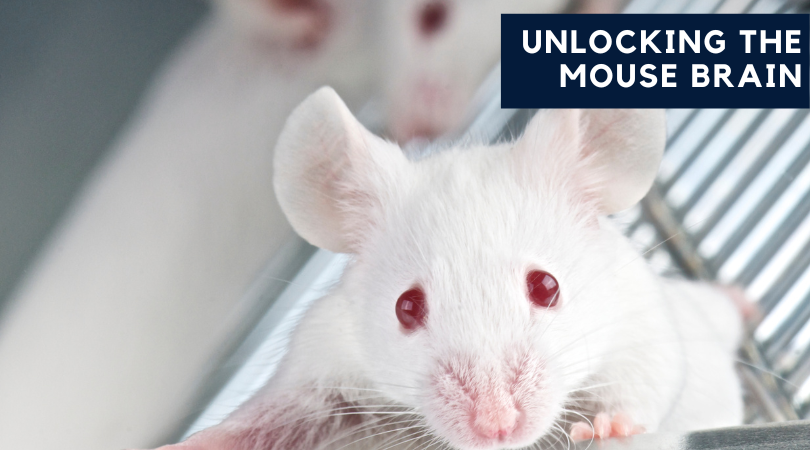Unlocking the Mouse Brain with VR (iMRSIV)
Posted on
The brain continues to be one of the richest areas of preclinical research, with experiments with mice helping researchers uncover a wide range of new insights into the intricate workings of the brain. From mapping the cell types in the mouse brain to developing virtual reality (VR) goggles for mice and exploring the neurobiological processes behind daydreaming, these advancements are reshaping our understanding of neural mechanisms and helping researchers unravel the secrets of the brain.
Surprising New Discovery on How Brains Age
In science, the conventional wisdom has been that the brains of animals with shorter life spans develop faster than those with longer life spans. 
That understanding has been upended by new research from the U.S. Department of Energy’s Argonne National Laboratory and the University of Chicago, which found that all mammalian brains mature at the exact same rate at every stage.
It’s unclear at this point what the implications of the discovery are for humans, since human physical development is much slower than that of other mammals, but it could lead to a more informed approach to a wide range of preclinical research, including drug development and treatment for neurological disorders.
A Complete Map of the Mouse Brain
Researchers at the University of California San Diego, the Salk Institute for Biological Studies, the Allen Institute for Brain Science, and other institutions have taken a big step toward a better understanding of the mouse brain.
After analyzing more than 2.3 million individual mouse brain cells and using AI to help identify cell types, the team created an unprecedentedly detailed map of cell types across the entire mouse brain.
The findings, part of the BRAIN Initiative, provide key insights into the brain's cellular composition as well as the organization and evolution of the brain. Researchers identified 5,322 different types of brain cells and explored the similarities and differences found in a variety of mammals, including humans.
The next phase of research aims to unravel the functions of these different cell types, understand the roles they play in diseases, and explore potential strategies for restoring proper brain function.
VR Goggles for Mice Could Revolutionizing Brain Science
Researchers at Northwestern University have introduced a groundbreaking tool for neuroscience research—Miniature Rodent Stereo Illumination VR (iMRSIV), a set of VR goggles designed specifically for mice.
Unlike traditional setups, iMRSIV offers a 180-degree field of view, fully immersing mice in VR scenes and blocking out the surrounding environment. The goggles enable researchers to observe how mice react in a fully simulated natural environment, including responses that are hard-wired in the brain, such as a reaction to the presence of an overhead predator.
The research, which allows a more accurate and precise study of the neural circuitry that underlies behavior in mice, opens new possibilities for studying brain activity during naturalistic behaviors.
The team believes that iMRSIV could not only deepen our understanding of brain function but also make neurobiology research more accessible. The relatively inexpensive and user-friendly nature of the goggles could pave the way for broader adoption in labs, making VR technology more available for studying brain activity in various experimental setups.
How Daydreaming Changes the Brain
What happens in your brain when you daydream? Researchers at Harvard Medical School have investigated the neurobiological processes of daydreaming in mice, uncovering interesting patterns of neuron activity in the visual cortex.
The researchers tracked neuron activity of mice in a quiet waking state. Occasionally, the brains of the mice would display patterns similar to when they were looking at actual images, indicating that they were daydreaming about that image.
What was unusual about the daydreaming brain patterns, however, was that they changed over time—an effect called “representational drift.” The daydreaming patterns gradually became more different, eventually becoming almost entirely separate from the initial patterns.
The discovery indicates that daydreaming may shape the brain’s response to things in the real world, meaning that daydreams can affect the plasticity of the brain and could have implications for learning and memory.
Looking at the Face to Understand the Brain
The eyes may be the window to the soul, but according to researchers at the Howard Hughes Medical Institute (HHMI), the face could be the window to the brain.
A team of researchers at HHMI introduced a cutting-edge tool called Facemap that is designed to predict neural activity in the mouse brain based on facial movements. The tool uses deep neural networks to connect mouse “facial expressions,” including eye, whisker, nose, and mouth movements, with neural activity in the brain.
Facemap builds on the discovery that certain brain activity in mice, previously thought to be “background noise,” is actually related to spontaneous behaviors.
The tool, which is free to download, could help uncover the relationship between facial movements and neural activity.